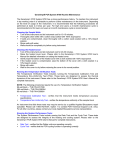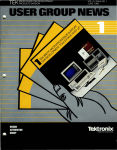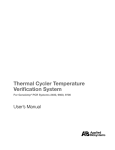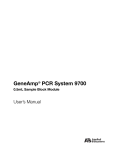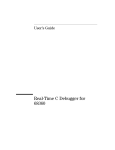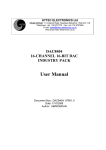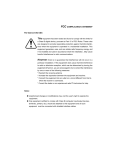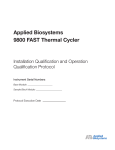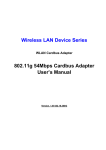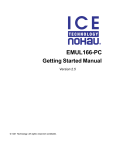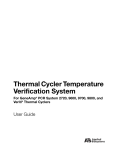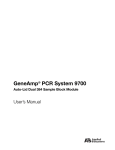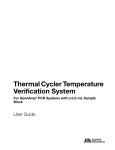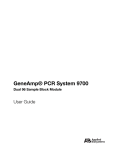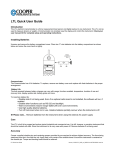Download Software Release Notice GeneAmp
Transcript
Software Release Notice GeneAmp PCR System 9700 1. Items List The release package includes: • This Software Release Notice. • A copy of the source code on a CD-RW for documentation control. 2. Supporting Documentation The design of the software is outlined in the document Software Design Document (softwdes.doc). The design of the user interface is outlined in the document User Interface Specification (9700spec.doc). Both of these documents are archived in the \tec\doc directory. The use of the 9700 is documented in the manuals: Manual name AB Part # 4331608 GeneAmp PCR System 9700 Users Manual in CD, it contains 4303481 • GeneAmp® PCR System 9700 Base Module: User's Manual: Rev E 4304192 • GeneAmp® PCR System 9700: Block Quick Reference Guide 4316011 • GeneAmp® PCR System 9700: 96-Well Sample Block Module User's Manual: Rev C (Gold, Silver and Alu) 4331607 GeneAmp PCR System 9700 Block Assembly User Manual in CD,it contains 4304215D • GeneAmp PCR System 9700 Dual 384 well Block Users Manual 4310838B • GeneAmp PCR System 9700 AutoLid Dual 384 well Block Users Manual 4307808B • GeneAmp PCR System 9700 0.5 ml 60 well Block Users Manual 4343363B • GeneAmp PCR System 9700 Dual 96 well Block Users Manual (Manul and AutoLid ) The 9700 Internet web site is http://www.appliedbiosystems.com/products/productdetail.cfm?prod_id=33 3. Hardware Configuration The hardware required for running this software is a Applied Biosystems GeneAmp PCR System 9700 thermal cycler. Hardware Base Module 96 Well Interchangeable Block Module-SILVER 96 Well Interchangeable Block Module-GOLD 96 Well Interchangeable Block Module-ALU Dual 384 well Interchangeable Block Module Dual 96 Well Interchangeable Block ModuleAUTOLID Manual Dual 96 Well Interchangeable Block Module 0.5 ml 60 well Interchangeable Block Module Ver 3.08 3.5” Disk for Up grades SRAM PC card for storing methods Printer cable PC serial cable for serial port upgrades Mac serial cable for serial port upgrades AB Part # N805-0200 N805-0251 4314443 4314445 N805-0400 4335726 4342718 4309131 0940-1064 N805-1326 N805-1327 N805-1328 4. Software Configuration Embedded in the firmware is a checksum for the boot section of code (address 0 to 0x3FFF) and a checksum for the application section of the code (address 0x4000 to 0x7FFFF). All firmware upgrade PC cards for Ver 3.10 should contain the following checksums, which can be verified by the instructions in Section 8, Subsection K of this document. Section Checksum Boot 0xE5E8 Application 0x8063 5. Software Generation See Section 8. System Generation of this document. 6. Software Reproduction See the Manufacturing guidelines for reproducing PCMCIA cards. 7. Software Installation To install the software on a 9700 which has a raw CPU board and no existing code in the Flash: A. Remove the back panel of the 9700 as instructed in Part G of Section 8 below. B. On the CPU board, move jumper SP10 to position 1-3. This jumper position tells the 9700 to boot off of the PC card instead of the CPU board Flash memory. C. Insert a 9700 upgrade PC card into the card slot on the right hand side of the 9700. D. Turn on the 9700. E. Press the following keys: 4311000 Page 2 of 8 F. G. H. I. J. • F4-Util • F1-Diag • F4-Upgrad • F1-Pccard • Stop/F3-Update and wait for the instrument to reboot. This key sequence will force an update of the boot and application section of the CPU board Flash memory. Turn off the 9700. On the CPU board, move jumper SP10 to position 1-2. This is the normal operating position that tells the 9700 to boot off the CPU board Flash memory. Turn on the 9700 and verify that the instrument powers up correctly and that the correct firmware version is displayed on the top-level screen. Turn off the 9700 and replace the back panel. To upgrade a 9700 which has an existing version of software (using PC card): A. Turn on the 9700. B. Insert a 9700 upgrade PC card into the card slot on the right hand side of the 9700. C. Press the following keys: • F4-Util • F1-Diag • F4-Upgrad • F1-PCcard • F3-Update and wait for the instrument to reboot. D. Verify the correct firmware version is displayed on the top level screen. To upgrade a 9700 which has an existing version of software (using Serial Port): A. Turn on the 9700. B. Connect cable from RS485 port on 9700 to serial port on computer C. Press the following keys: • F4-Util • F1-Diag • F4-Upgrad • F1-Serial • F3-Update D. Begin download of upgrade file from the computer using the Kermit protocol. E. Wait for instrument to reboot. F. Verify the correct firmware version is displayed on the top-level screen. NOTE: When upgrading the 9700 firmware through a PC card or the serial port, DO NOT pull out the PC card or disconnect the serial cable while the upgrade is in progress or there is the possibility that the boot sector of the CPU board Flash memory will only be partially written and the instrument will be INOPERABLE until it is re-programmed at the factory. If the PC card or serial cable is pulled out before the end of the upgrade, or there is an error during the programming of the CPU board Flash memory, the instrument will start issuing a series of beeps which can be deciphered by reading the error beep descriptions below. 4311000 Page 3 of 8 Power-up Failures This section describes beep patterns generated to indicate failures. These beeps will only be encountered at power on or reset of the instrument and when reprogramming the CPU board Flash memory during a firmware upgrade. Microprocessor Standby RAM Failure A read/write test is performed on the Microprocessor’s standby RAM at power-on. If it fails, a steady on -off on - off... beep is generated as follows: - - - - - - -... Resolution: Replace CPU board. CPU Board RAM Failure A read/write test is performed on the CPU board’s RAM at power-on. If it fails, the following beep pattern is generated. -- -- -- -- -- -- - -... Resolution: Replace CPU board. CPU Board Flash Memory Checksum Failure The checksum of the application section of the Flash memory is verified at boot time. If it fails, 10 quick beeps are generated. The following message appears if NO upgrade card is recognized in the PC card slot. FIRMWARE UPGRADE IS INCOMPLETE BEGIN DOWNLOAD OF FILE FROM PC -- OR -POWER DOWN 9700 INSERT UPGRADE PC CARD IN SLOT POWER UP 9700 The user can either initiate a serial port upgrade from their PC or follow the instructions for upgrading with a PC card. If a 9700 upgrade PC card is in the slot at power up, the user will hear the 10 quick beeps and the message FIRMWARE UPGRADE IS INCOMPLETE is displayed on the top line. The messages CHECKING FOR UPGRADE PC CARD and UPGRADING FIRMWARE… will follow. The instrument will reboot when the firmware has been upgraded. 4311000 Page 4 of 8 Invalid Checksum on Upgrade PC Card If the CPU board Flash memory checksum failure, as described above, is encountered and a PC card with incorrect checksums is inserted in the card slot, the user will hear the 10 quick beeps and the message FIRMWARE UPGRADE IS INCOMPLETE is displayed on the top line. The messages CHECKING FOR UPGRADE PC CARD and NOT A VALID UPGRADE PC CARD will follow. The instrument will continually beep until the bad PC card is removed from the slot. When it is removed, the message is the box above will be displayed. Firmware upgrade failure If a firmware upgrade fails because the data verify failed, the instrument will beep 20 times and then reset itself. Possible causes of this failure include a faulty CPU board, a faulty PC card interface or the operator removing the PC card or serial cable before the upgrade is complete. Resolution: When the instrument is powered on, a Flash checksum failure may be detected and the procedure to recover from this failure is outlined above. It is also possible that on reset or power on the software will start up correctly so check the firmware version displayed on the main screen. If not the same as the version on the PC card, repeat the firmware upgrade procedure. 8. System Generation This section describes the generation of the GeneAmp PCR System 9700 firmware. To regenerate the firmware, the following resources are required: Hardware Description IBM compatible computer The PC must be running MS NT /Win 2000, have at least 15 MB of free hard disk space. Nohau software development system Nohau’s 68332 BDM (Background Debug Mode) emulator card must be installed in the PC. Applied Biosystems GeneAmp PCR System 9700 thermal cycler Nohau’s BDM emulator cable must attach to the BDM connector J10 on the 9700 CPU board. 512KB SRAM PCMCIA card The Nohau BDM emulator will download a checksummed version of the 9700 firmware to this PC card. 1MB Flash PCMCIA card P/N 0940-1054 This PC card will be duplicated from the SRAM PC card and will hold the final version of firmware. ELAN PCMICA card drive This is the PCMCIA card reader/writer to duplicate the Flash cards. Software Description MRI 68332 This is the Microtec Research C/C++ compiler and 4311000 Page 5 of 8 compiler and linker ccc68k Ver 2.0F mcc68k Ver 4.5G lnk68k Ver 7.1C linker. BDM300 Ver 2.2X HLD, Nohau Corp. This is the Nohau emulator/debugger software. A. Setup the computer The PC must be loaded with MS NT or WIN2000 and should have at least 32MB of RAM and at least 15MB of free hard disk space. B. Modifying autoexec.bat and config.sys Add the following lines to your PC’s autoexec.bat file: • SET PATH=%PATH%; c:\tec\source;c:\mri\mcc68k;c:\mri\asm68k; • Set MRI_68K_INC=c:\tec\source\include;c:\tec\source\include\sys;c:\tec\source\rtxc;c:\tec\s ource\kernel;c:\tec\source\rtip\xnet; • set MRI_68K_BIN=c:\mri\mcc68k;c:\mri\asm68k;c:\mri\mcc68k\cpu32; Reboot the PC. Start MS Windows. C. Installing Source Files and Directory Structure 1. Create directory c:\tec 2. Copy the Directory Structure and all files from disk to c:\tec 3. Copy the MRI folder and all its' contents to c: (This is the compiler) D. Building the 9700 executable hex file The outcome of this will be a hex file named checksum.xeq in Motorola S-record format and will contain checksums for both the boot section and the application section of the code. This file is the actual executable hex file that will run the instrument. Change directory to c:\tec\source and type “ make –DALL –DHEX “, the source files will be recompile and link. Setting up the Nohau emulator • Install the Nohau BDM card in an empty slot in the PC. • Locate a 9700 thermal cycler. With the rear of the instrument facing you, undo the 2 screws on the back panel and gently pull the chassis of the 9700 about an inch away from the molded cover. Gently tilt the back panel about an inch away from the instrument. • Locate the 10-pin BDM connector J10 at the top of the CPU board and attach the cable from the BDM card. Turn the 9700 around so the keypad is facing front. Turn on the 9700. • From File Manager, locate the file k:\emul300\emul300.exe and double click on it to invoke the Nohau emulator. • Click on menu Config | Project name.. and select the project TEC_LEV2. Click on the OK button. 4311000 Page 6 of 8 G. Create a 9700 SRAM upgrade PC card • Click on menu Config | Emulator hardware.. to open the hardware configuration dialog box. • On the right side of the box, disable the Other Presets by clearing the checkmark next to the label “Enabled”. • Click on the button labeled “Restore previous user defined values”. • Click on the Reset button. • Click on the OK button. • Insert a 512KB or greater SRAM PC card into the card slot on the right side of the 9700. Before inserting, check that the write-protect switch on the card is in the Off position. • Click on menu Window | Open to open a new data window. • Click on menu Data | Fill.. • Enter Pattern 0, Starting address 0 and End address 80000. • Click on the OK button. This will zero out the first 0x80000 bytes of memory on the SRAM PC card. • Click on menu File | Load code.. and locate file k:\tec\source\checksum.xeq or I:\source\checksum.xeq if the subst command is in effect. • Click on the OK button. This will download the checksummed executable file into the PC card. • Remove the PC card from the slot and move the write-protect switch to the On position. H. Create a 9700 Flash upgrade PC card • Install the Elan card in an empty slot in the PC. • From DOS, start up the Elan software by typing \elan\jc_card. The version of the software is Elan Digital Systems LTD. Ver 2.08 Dec 1994. • Click on menu Misc | JC_CARD Address Setup and set the address of the card to 0xD0000. • Insert the SRAM PCMCIA card into the slot in the Elan card drive. • Click on menu File | File & path (Alt 1). • Select the TEC9700 directory and enter a file name. • Click on the Open button. • Click on menu Selections | Select Card (Alt 4). • Select AMD then click on the OK button. • Select AmC001BFLKA 1MB Flash then click on the OK button. • Click on menu Selections | Card Addressing (Alt 6) and enter 0 for the start address and 7FFFF for the end address then click on the OK button. • Click on menu Card Operation | Read (Alt R). • If a Card Selection Mismatch error occurs, see note1 below. • When Read Pass is displayed, click on the OK button. • Remove the SRAM PCMCIA card from the Elan card drive. • Insert the Flash PCMCIA card to be programmed (P/N 0940-1054). • Click on menu Card Operation | Program (Alt P). • Click on the OK button to program the card. • If a Blank Check Error occurs, see note2 below. • When Pass is displayed, click on the OK button. • Remove the programmed Flash PCMCIA card. • Verify the Flash PCMCIA card as per Section K below. 4311000 Page 7 of 8 Note1: If a Card Selection Mismatch error occurs Select one of the following other possible cards. Click on menu Selections | Select Card (Alt 4). Default Flash S1 x 16 bit, AMD AMC001AFLKA 1 MB FLASH, AMD AMC001CFLKA 1 MB FLASH, Note2: If a Blank Check Error occurs the card needs to be manually erased before it can be used. Click on menu Card Operation | Erase (Alt E). • Click on the OK button to continue the erase. • When Erase Pass is displayed, click on the OK button. • Program the card again. Click on menu Card Operation | Program (Alt P). • If a Card Selection Mismatch error occurs, see note1 above then set the card addressing again by clicking on menu Selections | Card Addressing (Alt 6) and enter 0 for the start address and 7FFFF for the end address then click on the OK button. • If a Pre Conditioning Error occurs, follow the direction above for a Card Selection Mismatch. J. Duplicate a 9700 Flash upgrade PC card • Click on menu File | File & path (Alt 1). • Select the TEC9700 directory and select the image file to duplicate. • Click on menu Selections | Card Addressing (Alt 6) and enter 0 for the start address and 7FFFF for the end address then click on the OK button. • Click on menu Card Operation | Program (Alt P). • When Pass is displayed, click on the OK button. • Remove the programmed Flash PCMCIA card. • Verify the Flash PCMCIA card as per Section K below. K. Verify the upgrade PC card (SRAM or Flash) Turn on a 9700 and press the following keys: • F4-Util • F1-Diag • Stop/F3-TmpVer • Highlight the service function Other Diags • Press F1-Run • F1-PCcard • F1-Run • Verify that the boot and applications section checksums that are stored on the PC card are the same as the checksums calculated by the 9700. • F5-Exit 4311000 Page 8 of 8








